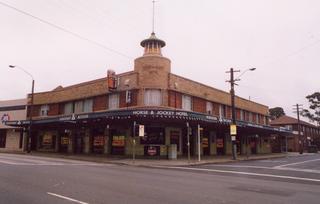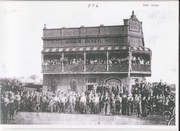
Horse and Jockey Hotel in Homebush (Sydney)
Horse and Jockey Hotel
Horse and Jockey Hotel
Information from Dave
"The original pub was named the Half Way House Hotel. The first account of Edward Powell retaining a license was 1809 and indications that the pub was actually operating for 2 yrs before that. Before that Edward was a sailor on the Second Fleet and after returning to England from Australia, decided to return taking up an offer for free settlers/ farmers needed in the colony. He returned to Australia on the ship Bellona with 4 other free settlers. These were the first free settlers granted land in Sydney. They were granted farming land inbetween Sydney and Parramatta. The idea was to establish farms half way between Parramatta and Sydney so their produce could be equally distributed between both towns.
The area was named "Liberty Plains" as they were free settlers. Their crops failed after only several seasons as the water from the creek (Powell's Creek now a canal running into Homebush Bay along side the old Arnotts Buscuit Factory) was brackish, and they had no way of re-fertilising the soil as there were no beasts of burden available in the colony that could give the land a good dose of animal dung. Edward Powell packed up & moved to the Windsor district seeking better farming land and became chief constable of the area. While in this role, he and several others were taken to court for killing two aboriginal boys. Amongst others, Matthew Flinders was at his trial.
Powell was found guilty, stripped of his status as constable, yet was given a conditional pardon on the grounds that he misenterpreted the Govt directive that natives should not be punnished unless proof of a crime. Powel had acted on heresay of locals, not direct proof. He moved back to his original land grant at Homebush and built the Half Way House Hotel hoping to capitalise on the increasing passing horses & wagons down the Parramatta road. This was around 1810. Parramatta road was a dog track in the bush at that stage.
Re Claim on oldest continual license.
Sadly it can't go in the records for the longest continuous licence for the following reasons Edward died in 1814
His wife then took over the licence from 1815 to 1818. (Licence states for sale of "victuals, beer, cyder & spiritous liquor").
When Elizabeth Powell died, the son (Edward Powell Jnr) was granted a licence in 1819. However in 1824 he was fined for not renewing his licence while still trading. He sold the Hotel to his brother in Law, James Underwood.
Shortly after the Hotel was advertised to be rented for a period not less than 7 years, most likely as a private residence & coaching stopover. It appears in this time it may not have operated as a licensed premises, yet the original pub seems to have re-opened again and was trading again under James Kerwin.
Underwood died (I think back in Mother England) around 1844. The pub must have changed hands through his death & this is about the time Kerwin appears.
The Homebush Racecourse was over the road on property of Darcy Wentworth, assistant surgeon on the second fleet and profound stateman in the early colony. His house Home-Bush Estate, gave name to the entire suburb. His son, William Charles Wentworth became a statesman as well and developed the Homebush Racecourse. He was also the Wentworth in "Blaxland Wentworth & Lawson" that first crossed the Blue Mountains.
An aside, huge colonial information firmly documented accounts of bushrangers and aboriginal attacks on the Parramatta Road near and around the the Half Way House Hotel on the Parramatta Road (Which became the Horse & Jockey). Fact: The first bushranger in Australia was shot and killed near here. His name was Black Ceaser. Shot with a bounty on his head and taken to the house of Thomas Rose where he died. Thomas Rose came here on the same ship Bellonia with Edward Powell as one of the first 5 free settlers in Australia. Rose had the land grant adjacent to Powell and they not only spent the long voyage over here together, they were neighbours when this happened. Rose's cottage was perhaps around 800 metres from Powell's hotel.
She may not be the oldest continuous licence yet she has a history that fascinates from the very earliest of times. How many pubs had their first publican as a Second Fleeter tried in court by Matthew Flinders amongst others for murdering 2 aboriginals and being granted a conditional pardon? This court case is one of the earliest in the colony to survive with a full transcript.
Horse and Jockey Hotel
Photo 01/01/1999.
Photo submitted by Jon Graham, Many Thanks
"Governor Lachlan Macquarie about this time makes mention in his diary that he and Lady Macquarie coached to the area and Lady Macquarie stayed at the Half Way House Hotel while Gov Macquarie inspected the state of the few scattered farms in the area on horseback.
There is record by the existing Powell family today that Edward Powell chatted with Gov Macqaurie stating to the Governor he had served England as a seaman on the Second Fleet.
Edward Powell had developed an orchard behind the Hotel and when he died around 1814 was buried in the orchard near where Homebush Rail Station is now. A map of Homebush Station (by State Rail) dated 1876, marks his (still visible at that time) tombstone as 'within the hotel land enclosure, near the railway fence".
Some time after, the old Half Way House Hotel was leased to a man named James Kerwin who was known as "Jemmy the Jockey". (most accounts now call him Jimmy, yet I have found a transcript of a court case in the 1840's that clearly names him as "Kerwin" and in two other accounts in the same court case name him as "Jemmy the Jockey".
I'm lead to believe by the older locals that the pub in the 1902 pic suffered a major fire and was re-built in the 1920's in it's present art-deco style. "
As an aside, the tower on the Horse & Jockey now, according to the elderly I've spoken to in the area, was built as a permanent reminder that the original Pub overlooked the racecourse and much illegal betting was done in the pub through a guy on the roof with a telescope.
Having said that it should be stated that the present Pub was built long after the racecourse closed, yet the designers of the new pub in the 1920's had in mind at the time there should be a memory in the design reflecting the grand old former days of betting. It's still a story the old blokes in their 80's in my area tell me, yet probably some truth in it.
References to races at the old Homebush Racecourse that at the start of the races, all dogs will be shot on the track. They were referring to dingos which still inhabited at that stage.
The racecourse ceased being the major racing venue in Sydney in 1860. The AJC moved the whole club to Randwick at that time, however the old Homebush course stayed open until around 1880 as a training track with the occasional major race. The area was subdivided in 1880. Parts of the racecourse became Chinese Market Gardens for a spell, other parts housing. Geeze now it's the Olympic City yet my place backs onto Powells Creek with park at the back and I can still overlay the old maps over the current streetscape and I live on the old racecourse.
Some other snippets about the Pub.
(1) When the Rugby League formed in Australia in 1908, one of the original teams was "Cumberland". The meeting to form "Cumberland' was held at the Horse & Jockey Hotel in that year. Although the Cumberland team were shortlived, they hold historical importance as being one of the original teams.
(2) The Boxer Sidney George Godfrey (1897 to 1965) was nicknamed the "KO King" and gained the Australian Featherweight Title in 1917. Upon his retirement from boxing he managed the Horse & Jockey Hotel until the mid 1950's. He was well liked by the patrons and during this time, the Horse & Jockey was often referred to as Godfrey's Pub.
Summary.
Licensed c 1807 Half Way House Hotel
Between 1876 & 1900 - rebuilt on current site(next door to the old Pub)
1920's Major fire and was re-built.


